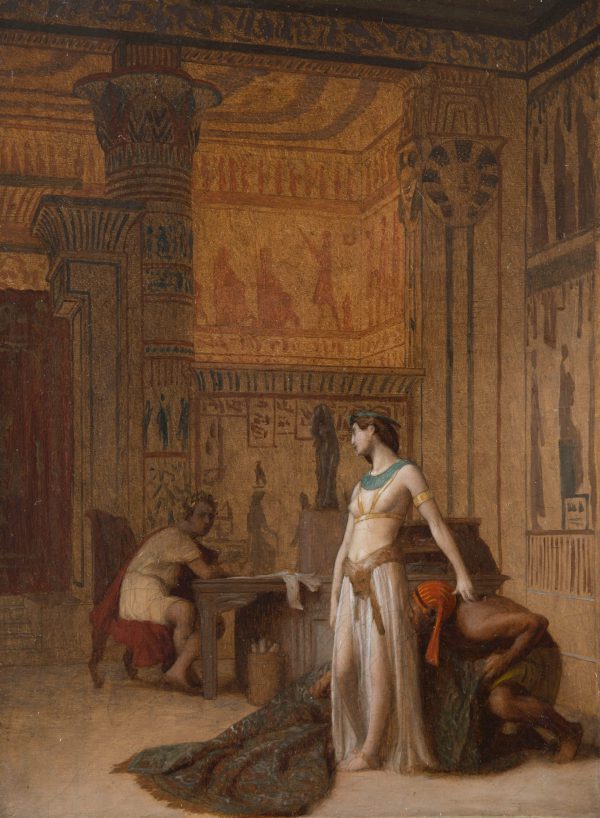Cleopatra and Ceasar, Ca. 1866.
Oil on canvas, H. 0.31 m; W. 0.23 m
Provenance: Aimé Morot (1850-1913), Gérôme’s son-in-law.
Madame Huisse, Rouen, 1970.
Schweitzer Gallery, New York, 1970.
Private collection, France.
Gerald M. Ackerman, Jean-Léon Gérôme. Monographie révisée. Catalogue raisonné mis à jour, Paris, 2000, p. 258, no. 159.2.
The authenticity of our painting has been confirmed by Gerald Ackermann.
Jean-Léon Gérôme is one of the most famous French painters of his time. A Professor at the Ecole des Beaux-Arts, Gérôme, was fiercely opposed to the Impressionists and became a symbol of academicism. Considered for a long time to be a reactionary, his reputation was restored by the pioneer work of Gerald Ackerman during the 1970s and 1980s.
At the age of sixteen, Gérôme entered the studio of the painter Paul Delaroche then at the height of his fame, whose principles would have a lasting effect on the young artist. He completed his training with a trip to Italy before attending the studio of Charles Gleyre, a major figure of academic art. In 1847, Gérôme enjoyed great success at the Salon with his Neo-Grecian painting Young Greeks Attending a Cockfight, also called A Cockfight (Paris, Musée d’Orsay), which earned him a third class medal, heralding the many honours of his future career.
From 1853 Gérôme travelled frequently and in 1856 he discovered Egypt. Fascinated by the Orient, he journeyed to the Middle East in 1862, 1868, 1871, 1872 and 1874, visiting Constantinople and Asia Minor in 1871 and 1875. The development of photography allowed him to create a study collection of views.
Gérôme’s many Orientalist paintings reveal his fascination for Arabic architecture. In addition his depictions of Oriental subjects are faithful to the Orientalist vision of his age, where sensuality and violence are combined. Thanks to the accuracy provided by his precise technique, they contribute a stamp of authenticity to the fantasy of the Orient.
Our painting prepares the Caesar and Cleopatra painted by Gérôme in 1866. It depicts the romanticized version of the first encounter between Caesar and Cleopatra according to Plutarch’s tale. The young eighteen year-old queen, driven from her palace by her brothers’ intrigues, had decided to convince Caesar to restore her to the throne. To reach Caesar unnoticed, Cleopatra crept into a package of carpets and asked her friend Apollodorus the Sicilian to carry her to him. Caesar was captivated by the daring, conversation and charm of the young queen.
This painting was commissioned by the Marquise de Païva, one of the most famous courtesans of the time, for the luxurious house she had just built on the Champs-Elysées. Finally refused on delivery, the painting was then bought by the painter’s father-in-law, Adolphe Goupil.
To date, two oil studies (including our painting) are known, as well as three preparatory compositional drawings and two figure studies, one of Cleopatra’s head and the other, of her friend Apollodorus. In the initial sketch, a drawing at the Musée Georges Garret à Vesoul, Gérôme shows us Caesar in full length, rushing to lift Cleopatra who was still on the ground. A similar drawing, with some of the background architecture traced with a ruler, was presented by the Galerie Paul Prouté in 1987. An initial oil sketch also repeats this arrangement. Another drawing of the composition shows Cleopatra standing, elegant and unsurpassed, in front of Caesar who in astonishment remains glued to his seat. Our oil study also shows Cleopatra standing and Caesar immobile, in the same position as in the drawing. While in the final painting, Caesar, still sitting but in a more tonic attitude makes a gesture of astonishment with his left hand.
The architectural background is a faithful copy of a coloured plate from the Description de l’Egypte showing the small temple at Deir el Medineh. In the final painting, this background is reversed, allowing a formal response to the figure of Cleopatra to be given by the column at the back. The figures’ costumes, especially Cleopatra’s split skirt and Apollodorus’ headdress (mid-way between a Pharaonic nemes and a Bedouin veil) are the fruit of the artist’s fantasy and reflect an imaginary Egypt.


